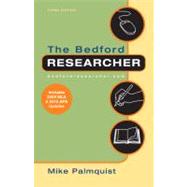Tech-savvy and student-friendly, The Bedford Researcher addresses the kinds of writing students actually do and the kinds of sources they actually use. It follows real student writers from their initial research questions all the way to designing their final essays, integrating electronic sources and tools into each stage of the process. Clearly organized and readable, The Bedford Researcher strips away the complexities of research writing and empowers students to write with confidence.
"The Bedford Researcher helps my students develop the skills they need to research responsibly in today’s digital environment."- Robbin Zeff, George Washington University








